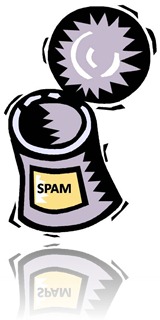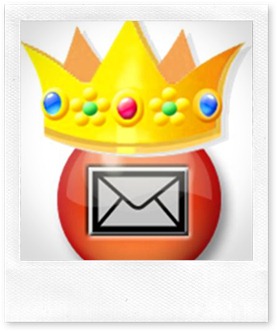Entries Tagged 'freelance copywriter' ↓
May 12th, 2010 — copywriter, copywriting tips, freelance copywriter, marketing

If there was a single blue print for effective copywriting, I’d be out of a job and all the sales and marketing writing in the world would become predictable and boring.
The structure of persuasive copy is fluid – there isn’t a ‘one size fits all’ solution. So, if you arrived at this post hoping to receive a check-list outlining how to write persuasive copy every time, you’re out of luck.
However, persuasive copy does contain certain elements that crop-up again and again. So without further ado, here are a few pointers to get your copy off the ground.
Elements of persuasive copy
1. Focus on your reader
This is vital and yet there is a lot of copy out there that doesn’t. Your reader is only reading your copy because they think there’s something in it for them. But if you don’t tell them what that is from the outset, they’re not going to keep reading.
Make an impact by giving them an important promise immediately either in the heading or the opening paragraph. Tell them exactly what’s in it for them to get them hooked.
2. Stay focused on your reader
Just because you have them hooked doesn’t mean they’ll finish reading your copy just to please you. Every section of the remaining copy must have a central idea and purpose – don’t waffle. And don’t digress, your copy must always support the main promise you made at the outset.
3. Be specific
Your reader has a built-in BS detector so if you try to pull the wool over their eyes, they’ll spot it a mile off.
The most persuasive copy contains supporting evidence that is specific and qualified.
4. Build credibility
How can you persuade your reader your product is for them? Use statistics, external references, case studies, testimonials etc. These will all build your credibility and show your authority as well.
5. What was in it for them again?
Don’t ever let your reader lose sight of what’s in it for them. Tell them again and again. Reaffirm it with your evidence.
6. Have a stonking offer
By the time your reader has reached here they should be sold on your product. But the offer you make them is going to be key as to whether they buy or not.
7. Sum up
Just as any good Barrister would in a court of law, sum up why your reader should buy. Return to your original promise and show them how you’ve fulfilled it – just in case they missed anything.
8. Call to action
Don’t get all the way to number 7 without adding a strong CTA. By number 7 your prospect will have their hand on their wallet ready to open it. But if you forget the CTA, they’ll just put it back again.
Make it commanding – if you want them to complete an order form make sure it is simple to use. If it looks to complicated they’ll wiggle off your hook and go elsewhere.
So there you go, although there isn’t a set method of writing great copy, by incorporating these elements you’ll get your reader hooked.
Why not give it a go?
May 10th, 2010 — copywriter, copywriting tips, freelance copywriter

One of the best things about being a freelance copywriter, is I get to help other people.
Not just my clients, but other aspiring copywriters.
I receive a number of emails from would-be copywriters looking for hints and tips to help get them started.
They find me either through this blog or through my company website Briar Copywriting.
I love receiving these emails and I always reply to them and give them whatever advice I can. Which is what prompted me to put this post together. Hopefully, I will be able to answer all the common questions in one go.
My journey as a freelance copywriter started in 2007. I was very green back then and was grateful for any advice I could get. So here goes, these are the most frequent questions I get asked:
1. How do I get work?
Yup, that’s always the hard one to answer. Everyone’s background is different. If you have worked as a copywriter within a company and want to go it alone, you’ve probably got potential clients you can approach.
If you are coming into this industry without that leg-up, it’s a bit more difficult. Some copywriters will ‘cold call’ – normally by phone. They’ll contact local companies and try to get work that way.
Another option is to write copy in the hope of attracting clients. For example, if you see sales literature for a company that really isn’t very good, you could re-write it, send it to them and say, if you like it pay me £xxx if you don’t, that’s fair enough.
I was fortunate when I started out. I immediately walked into a paying job and within weeks of setting up, had clients knocking on my door. That isn’t always going to happen though so you’ll have a lot of marketing to do. Get out there and meet people. Go to local networking events to generate a buzz and to get people talking.
2. How do I get a portfolio together?
This is the chicken and the egg scenario – how can you show a perspective client a portfolio of work when you don’t have any clients!
Think about your past work history. What did you do? Can any of that be used to show your writing skills? Even if it’s stuff you did in a voluntary capacity for a local PTA or other organisation, it can still be used. Remember, you are unlikely to be walking in to see large Blue Chip Companies when starting out, so don’t worry about your portfolio looking a bit ‘lame’. You can build on it with every client you get.
3. Is there a copywriting course I should go on?
Let me answer that one this way – I do not have any formal writing qualifications. I have a BA(Hons) in English Language and Literature but I have never taken a copywriting course.
As long as I can remember I’ve always been a writer. And it’s the quality of my work that attracts clients, not the qualifications I hold.
Besides, one thing my clients often say is they like working with me because I bring a fresh take to things. I’m not blinkered to any particular formulas or rules. When I receive a project, I take into account the business, the product, the audience, the media and then create something original that will work for that audience and client.
So, don’t get hung up on thinking you must have a copywriting qualification. Clients will choose you on the quality of your work, not how many letters come after your name.
4. Do I need a website?
Yes!!!!
Your website is going to say a lot about you so don’t scrimp on it. Go to a good web designer (and one who understands SEO) and make sure you get a professional site that is clear, compelling and simple. After all it will reflect your professionalism, your values and your service.
5. Do I need to understand SEO?
Search engine optimisation is essential for your clients and for your business.
It is big business these days and clients are always looking for a copywriter who actually understands SEO. But not only that, you have to understand SEO to get your website ranking well.
My website ranks for all my major keywords. Because of this, I don’t have to go chasing clients. These days clients come to me. They find my website in the search results and commission me – it really can be that easy. Because of this I don’t pay for advertising – my website does that for me.
6. How can I improve my writing?
The simple answer to that one is to write. The more you do it, the better you’ll get. The world of sales and marketing is changing all the time so there is always something new to learn. Plus the more you write the more objective you’ll become towards your own writing so you’ll continuously improve.
You can also improve by reading a lot. Both fiction and non-fiction will help you by exposing you to different styles.
Plus, when you’ve written something for a client, read it out loud. You’ll probably feel a right Charlie, but it will help you identify areas that aren’t working. Make sure you put on your voice-over voice too. Although it will sound very contrived, using intonation and excitement in your voice will help you identify areas that don’t flow because the rhythm is off.
Another way is to watch other writers you admire. Read their work and analyse what they do. This is a great way to pick up tips and ideas that you can transfer into your own work.
7. What else do I need to know?
One of the other essential things you must do is back-up your work constantly.
I have a USB external hard drive that is set to back up my files at certain times. Plus, I also use the Carbonite service which constantly backs up specified files to my Carbonite web space. Once I’ve made an amendment to a file or created a new one, Carbonite waits until it is inactive and then backs it up immediately. I also have a separate portable external hard drive that I regularly back up.
I hope that quick run down has helped answer any question you might have. If you need to know anything else get in touch or make a comment on this post.
Good luck.
May 5th, 2010 — copywriter, copywriting tips, email marketing, freelance copywriter

There are three things every email marketer wants to achieve:
- They want their message to be delivered
- They want to establish a relationship of trust with their mailing list
- They want their emails to be read
But, if you want to become known as an email spammer that won’t be important to you. You won’t care about your recipient. You’ll go out of your way to send annoying emails. You will want them to unsubscribe from or block your messages.
To help you become a spammer extraordinaire, just follow these tips:
1. Never use a real name
Don’t you just hate it when you get emails from real people? Wouldn’t it be better to conceal your true identity?
Who cares if your email shows it’s come from Sally Ormond or Briar Copywriting? It would be much better to use something like ‘Bulk’, ‘List’, ‘Blank’. The recipient will never guess it’s a spam email with a senders name like that.
2. Make sure your subject line rings alarm bells
Subject lines that make sense are so boring. It’s much better to use something nonsensical – Brodie tell freelancecopywriter.com – fab! That tells the reader absolutely nothing. Of course, if you really want to get their attention THERE’S NO BETTER WAY THAN USING CAPITAL LETTERS!!!
3. Don’t send it to real people
Do you really want to spend time making sure you have a real person’s name in your recipient’s email address? Of course not. Just sent them out to generic addresses. Yes, some might get stuck in spam filters but there’ll be some that get through.
4. Use catch phrases where possible
Why waste your time trying to come up with a strong subject line that is informative and eye catching? Go with the good old ‘free’, ‘cheap’, ‘GUARANTEED’, ‘no obligation’. It’s not as if your recipients are going to be bright enough to work out we only use those words to make them open our emails.
5. Don’t worry about the quality of your copy
People always bang on about making sure you proofread everything. What’s the harm in the odd spelling mistake, punctuation balls-up or grammatical error? They’ll be so busy they won’t even notice.
6. Don’t get cocky
If you’re confident in your writing you’ll make your reader think you know what you’re taking about.
Keep it vague. Use words like ‘I was wondering’, ‘perhaps you could’ – I mean, it’s not as if we want the reader to take action is it?
7. Send it to anyone
I’m not into all this sending information only to those who are interested. How do you know if someone is interested or not? I mean, it’s like those emails you get from SEO companies. It’s not like they’ve got time to check to see if the company they’re mailing out to is on the front page of Google or not is it? OK, so the copywriter we emailed was on the front page for the term ‘copywriter’ but I bet there are some terms they’re not on the front page for. That’s why it’s important to be vague in your email – specifics will only cause problems.
Why do you need to know this?
If you want to become known as a spammer, these 7 tips will help you.
But if you want to avoid that particular tag, remember:
- always use a real name in the sender field
- ensure your subject lines make sense, are informative and don’t use capital letters
- send your emails to a real address including a persons name
- avoid catch phrases and words like ‘free’ ‘cheap’ ‘GUARANTEED’
- make sure you proofread before sending out your email
- write with confidence, if you want your reader to take action, tell them
- make sure your email only goes to those who would be interested/or would benefit from your product/service
May 3rd, 2010 — copywriter, copywriting tips, email marketing, freelance copywriter

The advent of email marketing has revolutionised the way many businesses market themselves today.
Never before have you been able to market to so many people, so quickly and cheaply.
But as well as being one of the most efficient forms of marketing, it can also be one of the most damaging if you get it wrong.
How to get email marketing right
One of the most important aspects of email marketing is your list. Yes, you could take a short cut and go and buy yourself a mailing list, but will that really work?
By far the best mailing list you can have is your own in-house list. Yes, it will take time to build but its quality will be far superior to anything you can ‘buy off the shelf’.
Of course, to do this you have to get people to part with their email addresses which isn’t as easy as it sounds. You’ll have to offer them something worthwhile – great information, fantastic tips, special offers.
How to generate sign ups and keep them
I have put together 7 simple steps to help you get your email marketing right. Follow these and you’ll increase your sign ups and keep them subscribed.
1. Make is easy
If you want someone to sign up for your newsletter/email marketing, you have to make it easy for them.
Just ask for their email address – at this stage you don’t need anything else. Long forms asking for loads of information will not be attractive. Remember at this stage you’re not looking at generating leads, all you want is an email address so you can add value to your relationship with them.
Also, make sure you reassure them you won’t spam or pass on their details to a third party.
2. Sign them up
A visitor to your website isn’t going to hunt round it for your sign up box. So, you have to make sure your sign up box is prominent. You could place it on every page of your website, but why not also have it on your order form or even in your comments section.
That way, whenever they interact with you, you are giving them the opportunity to opt in to your mailing list.
3. Use a reliable service
There’s nothing worse than collecting loads of email addresses and then using a service that is going to constantly let you down.
You need one you can rely on to produce attractive and robust email/newsletter templates that are delivered first time, every time. I would recommend the Aweber service.
4. Work on your subject lines
Your subject line has to grab your recipient’s interest if you want them to open it. Don’t use anything spammy – go for things like ‘Tips’, ‘How to’, ‘Discover’, ‘Learn’.
If your company’s brand is well known, use it in your subject line so it is instantly recognisable as something to be read.
5. Make an impact
Most people, when they open your email, will just quickly scan the first few lines to see if it’s worth spending time on. So make sure your important information comes first.
Hit them hard and fast – grab their attention and draw them into the rest of your message.
6. Test
The best way to hone your email marketing skills is to split test. Divide your mailing in two and send out the same email but with two different subject lines.
Monitor which has the best open rate – learn what generates the best response and continually develop it. Over time you’ll begin to create powerful emails that really sell.
7. Make sure you give value
If you want people to subscribe and stay subscribed, you have to give them great information.
Sending them constant sales messages will just turn them off. You need to listen to them, give them information that will be of use to them. If your customer service team are fielding the same questions over and over again, use this in your marketing. Answer their questions and show them you listen.
If you get your email marketing right, you’ll develop strong and loyal relationships with your customers and boost your sales. You’ll become a name they know and trust. But it is all too easy to get it wrong.
Test, reliable services, great offers, valuable information – these are the things that will make your marketing work.
Sally Ormond – freelance copywriter
April 28th, 2010 — copywriter, copywriting tips, freelance copywriter

Whether you are talking about your sales website or your company blog, if your copy is lousy it’s going to let you down – big time.
Remember your school days? How the good looking kids always seemed to get an upper hand; you never saw an unattractive sports team captain, the head boy/girl was always gorgeous etc. Well, your website or blog is going to follow exactly the same trend.
Learn to be attractive
It pains me to have to admit that being attractive is the best way to get where you want to be. At school I was the ‘ever-so-slightly-heavier-than-she-should-be’ kid who was the last one to be picked during PE lessons. To try and lift me, my parents would come up with the old classic ‘looks aren’t everything’ – but the problem is, they are – at least to a certain extent.
To me, as a copywriter, the copy on your website or blog is paramount. It is that that does the hard work in engaging with your reader and getting them to place an order. But the look of your website or blog is going to have an effect of whether your reader actually stops to browse your site.
If you have an attractive looking site, that’s pleasing to the eye, someone is more likely to stick around and have a look. Of course, if the copy on that site is shocking, they’ll leave. Equally, if you have incredible copy on a God awful looking site, they’re not going to hang around long enough to read it.
Getting the picture?
There are many things you can do to make your website gorgeous, but rather than listing all of those, here are some things you should avoid at all costs:
Know who you are writing to. Your audience has specific needs – all you have to do is identify those and satisfy them.
Make sure you don’t try and talk to everyone. Have a single reader in mind when writing your copy. You can’t address everyone because if you try you’ll just end up creating copy that is confused.
Plus, when it comes to the length of your post, be sensible. Although your reader is going to want something that answers all their questions, they probably won’t have the time to sit and read your version of War and Peace. Make sure your copy is measured and complete but keep it relatively brief.
When you begin to write, think about how it looks. If your reader is faced with a wall of text that extends down their screen which the have to scroll through, they will be severely turned off.
Break your copy up into manageable chunks. Use sub headings to indicate what information is to follow so they can dip into your copy and read the most relevant parts to them.
Make it easy to read by using a high contrast between text colour and background – go for black on white or white on black. You don’t want your reader to have to strain to work out what you’ve written.
Before you even start thinking about the body of your copy you need to come up with a masterful headline that will grab your reader’s attention and make them want to read on.
If you produce dull copy, it won’t be read. Writing about how great you are or producing something that is stuffed with jargon, won’t get read. There is only one thing you have to keep in your mind – what does your reader want to know. To give you a clue it will probably have something to do with ‘What’s in it for me?’
At the end of the day, your reader will only spend their precious time reading your copy if they are going to get something out of it at. Harsh but true.
You will want to make your copy look appealing. But be careful with the colour. Splashing your page with a rainbow of colours will make it look gaudy rather than engaging. Stick with just a few colours that fit with your company’s image.
Also don’t over do the design elements on your site – less is definitely more. If you have too many pictures, logos, flashing images or banners on your site it will be distracting to your reader. Keep it simple.
Why do you need to know this?
Getting either your copy or your design wrong could effectively kill your site. You must make sure you consider both elements and how they need to work together.
If in doubt always go for less is more.
Sally Ormond – freelance copywriter










